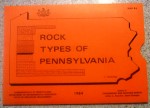•Publishing Organization: Pennsylvania Geological Survey
•Map Scale: 1:500,000
•Commonwealth of Pennsylvania, Department of Environmental Resources, Office of Resources Management.
•Publication Date: 1984
•Bureau of Topographic and Geologic Survey, Arthur A. Socolow, State Geologist.
Red Shale;
The formation of mud begins with a breakdown of rocks. The resultant small particles become part of the local soil. Rainstorms wash tiny particles of soil from the land into streams and low lying areas, giving the water a "muddy" appearance. When the stream enters a standing body of water such as a lake, swamp, or ocean, the mud particles settle to the bottom. Undisturbed and eventually buried by more of the same, or ash or lava, this accumulation of mud can be transformed into a sedimentary rock known as "mudstone." Under tremendous weight, the mass transforms into a sedimentary rock known as shale. The red color of the shale found below Bonneauville comes from small amounts of iron in the soil.
•Incidentally, Shale is a very common rock found on Mars, making it at least one thing that the town has in common with the Red Planet.
•A very limited number of types of fossils are found in Bonneauville area shale. See Cat. No. 1985-03 for examples.


